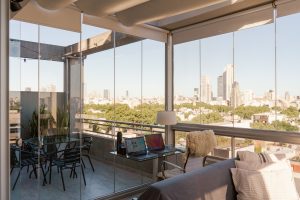What Buenos Aires has felt like has only one explanation: love at first sight. Few places have embraced me so quickly, so deeply. Starting this journey through Latin America in the Argentine capital has been a balm for my nerves—a perfect thread to pull at as I begin to unravel where this path might lead me.
If I had to define Buenos Aires in one word, it would be personality. Because that’s what it is—a living character, a city with a soul that doesn’t just exist, but performs. It laughs, cries, argues, sings, and talks endlessly with its unmistakable porteño accent. They say Argentines can psychoanalyze you with a glance, and Buenos Aires is their favorite therapist’s couch.
The people I’ve met so far have made all the difference. Thanks to them, deciphering the city’s complex personality feels not only possible—but delightful.
A Family Welcome
Some time ago, someone mentioned I had an uncle in Buenos Aires—my mother’s brother, who arrived here as a missionary almost half a century ago. Though the city offers all types of accommodations, he offered me a room at the House of the Priests of the Church of the Miraculous Medal, a devotion held in deep reverence in these lands. And so, it’s from a humble table in a modest parish room that I’m writing these lines, filled with first impressions and early amazement.
Expecting the Corners of Downtown Buenos Aire
Almost immediately after arriving—before even unpacking my backpack—my first outing into this summer-soaked Buenos Aires began. My uncle and I wandered downtown, using Plaza de Mayo as our anchor. At one end stands the Cabildo, a vestige of Spanish colonial rule; at the other, the iconic Casa Rosada, the seat of the Argentine presidency. In between, the Pyramid of May rises in tribute to the 1810 revolution that sparked Argentina’s independence.
The Plaza, vibrant no matter the day, beats with political memory. It’s the home of the legendary Mothers of Plaza de Mayo, who still march for the memory of their children disappeared during the dictatorship (1976–1983). They are perhaps the most poignant symbol of this space—a place where history breathes.
Layers of Time in Stone and Sky
We stepped inside the Metropolitan Cathedral, an 18th-century structure housing the Mausoleum of General José de San Martín, liberator of Argentina, Chile, and Peru. There, in the sacred hush, we watched the solemn changing of the guard. The cathedral itself is a mix of Romanesque, Baroque, and Neo-Renaissance styles, standing proudly beside the more modern heartbeat of the city.
Avenida de Mayo and the City’s Voice
From there, we walked the kilometer-long Avenida de Mayo, framed by leafy trees, historic theaters, and elegant cafés like Café Tortoni, frequented once by the likes of Gardel and Borges. Along the way, Florida Street tempted us with its endless offerings—a pedestrian paradise where if it doesn’t exist, it simply hasn’t been invented.
But it was Avenida de Mayo, that main artery of the city, that led us deep into the city’s essence. Crossing the sprawling Avenida 9 de Julio—18 lanes in some parts—we paused at a modest café to chat. We spoke of Argentina, of Spain, of life on both sides of the ocean. My uncle, a lifelong storyteller and listener, has always visited us. Now, finally, it was me visiting him in the land he has made his own.
As the day began to wind down, we reached the Palace of Congress, its 19th-century majesty glowing in the golden light. The air grew softer, cooler. Buenos Aires whispered in every step, around every corner.
We returned by Subte, as they call the subway here. The ride was short, the echoes of the city long-lasting.
First Impressions That Linger
Buenos Aires isn’t just a city you visit. It’s a presence you encounter. A personality that walks beside you. My journey has only just begun, but already I know—this city won’t let go of me easily.



















